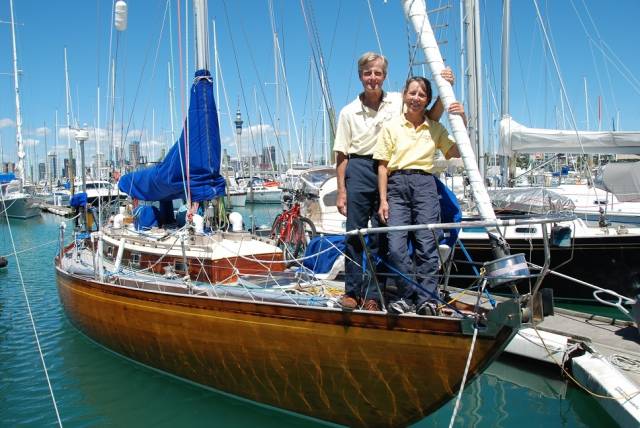We take it for granted, and it’s always there - whether we like it or not. The good old Irish Sea. But could it be that there’s a new and growing awareness of just how much the Irish Sea can offer if you’re interested in cruiser-racing which really does test a boat and crew’s ability to do what the boat was designed to do? In other words, going offshore, and staying offshore for a decent distance of the course, rather than using the boat only for semi-inshore races which could perfectly well be done by craft with no accommodation at all. W M Nixon wonders if the long-forecast re-birth of the Irish Sea Offshore Racing Association really has been happening while we all were looking elsewhere.
It was some time ago now, several years it must be, when a function was scheduled for the National Yacht Club in the dark days of November. At it, former enthusiasts from both sides of the Irish Sea were going to get together to have a proper-job black tie gala dinner to finally lay to rest the ghost of the Irish Sea Offshore Racing Association, which had been attracting little or no turnouts for events which used to be the backbone of a busy annual offshore racing programme which had been the envy of many comparable sailing areas.
Part of the idea was that by giving it a decent burial, the numerous trophies could be re-distributed to clubs which might find a better use for them, and who knows, but maybe in individual cases specific and historic distance events might be kept going on a stand-alone basis.
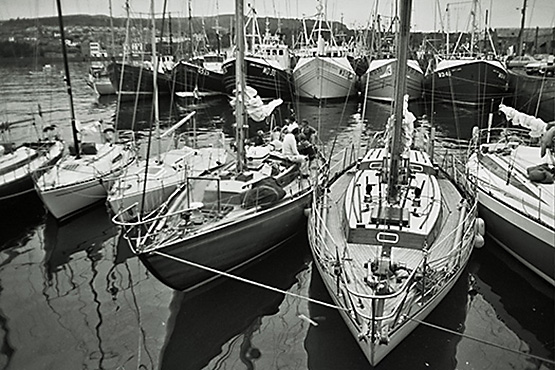
Sunstone (centre) with ISORA racers among the fishing boats in the pre-marina days in Howth during the 1970s. Photo: W M Nixon
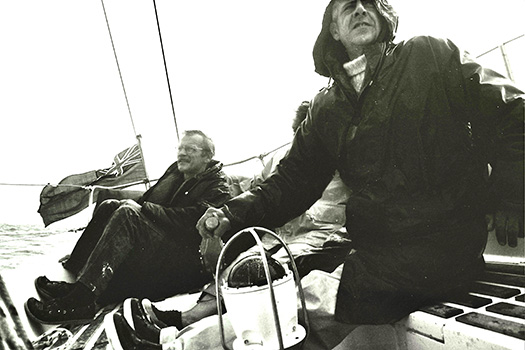
If ISORA could be said to have a single founder back in 1971, it was Dickie Richardson of Holyhead (left), seen here aboard his Ohlson 38 Matthew Walker which he completed with his sons from a bare hull. Photo: W M Nixon
At least that’s my recollection, but it’s vague in the extreme, for although like many the annual ISORA programme used to dominate my summers, those days were long gone, surrendered – sometimes rather unwillingly, it has to be admitted – to growing family demands.
Time was when the husband of the household was expected to be away at sporting things most weekends. But that attitude was changing very rapidly, and you only had to look at ISORA turnouts to see the change in domestic priorities taking place as a fact of life in its new form.
Of course there were some splendid family crews racing offshore involving two and sometimes three generations. But as other forms of sport and specialist interests developed, such crews became increasingly rare, and anyway offshore racing wasn’t everyone’s cup of tea. So you could argue that the thing that almost killed off ISORA was the most scary advertising slogan of our times, five seemingly innocuous little words which promote any event or activity which reflects the new domestic priorities.
“FUN FOR ALL THE FAMILY!!!!!!” For dyed-in-the-wool offshore racers of the rather anti-social traditional type, hearing or seeing this chirpy message was like showing the sign of the cross to a vampire on the prowl. And for enthusiasts of the smelly crazy sport of taking a three day weekend to position and return an offshore racer for a distance race involving kindred spirits from God knows where, it meant death by a million painful pinpricks.
So much so, in fact, that we who were formerly addicted were brainwashed into totally abandoning our old ways. Thus when I heard that a dinner was maybe being planned to wind up dear old ISORA, excuses were readily forthcoming for being elsewhere.
Except that reports of the death of ISORA proved to be greatly exaggerated. Memories are vague in the extreme. And anyway I wasn’t there, even though I’d been in and around the birth of ISORA way back in the early 1970s. But in this instance I don’t want to spoil the myth by asking specific questions of those who were there a few years back about that supposed Laying To Rest That Never Happened. For my impression is that, owing to a November mega-gale, the ferry from Holyhead was unable to sail. The Welsh and English contingents didn’t get to the requiem dinner in the first (or last) place. And the Irish crowd enjoyed themselves so much they decided they were going to keep ISORA going after all.

The National Yacht Cub, where ISORA was re-born

Failure is an orphan, but success has parents everywhere. Nevertheless I think few will disagree with the assertion that it is former NYC Commodore Peter Ryan, with the help of Stephen Tudor from Pwllheli, who has done most to keep ISORA going on life support, and then start to revive it actively with sponsorship from Avery Crest when the time is right.
And that right time seems to be right now. ISORA is putting Lazarus in the ha’penny place with a very healthy turnout for today’s 54-mile Dun Laoghaire to Holyhead Race. With 28 boats coming to the line, and it still only mid-May, we’re looking at substantial growth which shows every sign of being sustainable, so maybe we should try to explain the odd appeal of short to middle distance offshore racing.
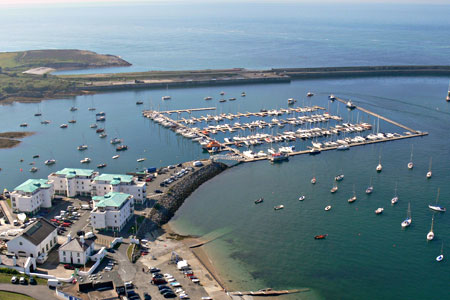
Holyhead is the destination for today’s ISORA cross-channel race. The marina in the corner of the harbour known as Porth y Fellyn is a world away from the popular perception of Holyhead as a raw ferry port.
Part of the answer has to be that once you’ve fulfilled all the complex tasks of bringing your boat up to the required standard in terms of equipment and crew qualifications, the actual event itself could not be simpler. The basic simplicity of an offshore race is its USP in today’s ludicrously complicated world. Unlike complex inshore multi-race regattas, there’s just one start, just one course, and just one finish line. Heaven knows but our everyday lives are weird enough and busy enough these days, thus it’s refreshing to find a sport whose basis is so utterly simple.
Of course there are all sorts of complexities of winds and tides and tactics and strategies underlying this basic simplicity. For instance, to an outsider, surey nothing could seem simpler than a race from Dun Laoghaire to Holyhead? Believe me folks, it may be a straight line across channel. But once you’re into it, you find the factors involved are infinite in their variety.
Yet underneath it all is this appealing simplicity of just the one start and just the one finish. And it goes on for long enough to build up a silent but strong relationship with the boats and crews you’re racing against. That old sailor’s opinion: “I don’t like the cut of his jib” can begin to have real meaning.
At ISORA’s height when the annual season-long points championship could involve more than a hundred boats when every event was included, the fleet was as diverse as it was long-lived. Today you see boats of the S & S 34 class, or a whole raft of Swans, or boats like Sarnia or Setanta, as being interesting yet still very much alive relics of a different age of sailing. And in this historic list, one boat in particular stands out. When we raced against her, she was called Dai Mouse III and she was owned by a Cheshire publican called David Hague. But nowadays - and for more than 25 years – she is known as Sunstone, the 40ft S&S sloop which Tomy and Vicky Jackson cruise the length and breadth of the globe with such competence that they recently became the latest awardees of the annual Blue Water Medal of the Cruising Club of America, which is tops of the tops.
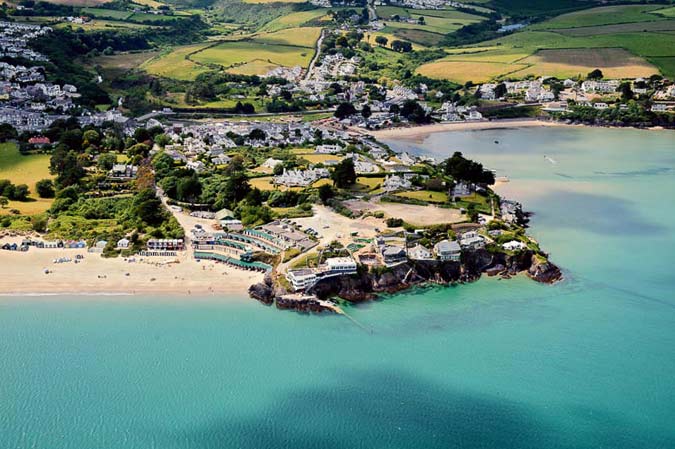
Abersoch on the Lleyn Peninsula in North Wales is another ISORA location. The clifftop clubhouse of South Carnarvon YC is reputedly suspended from its roof in a masterpiece of engineering.
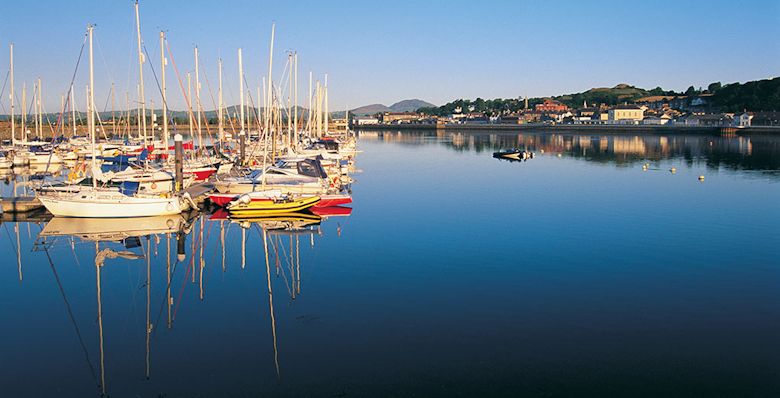
Pwllheli provides total shelter at the head of Tremadoc Bay when the ISORA fleet is in port
But for old ISORA hands, the attitude is that Dai Mouse III is doing well for herself, and it’s just right and proper. They could be an odd bunch, the ISORA people. The kind of people who take to offshore racing aren’t people who indulge in passing fads, and throwaway entertainments. They’re literally in it for the long haul. Yet they’re not the kind of people who’ll necessarily attach themselves to the high profile glitzy glamorous offshore events. Rather they go for the straightforward low-key distance races with a strong local tinge, races which provide them with private satisfaction, and an absorbing way of relaxing at weekends.
So obviously it’s not for everyone. In fact, it’s obviously not for the vast majority of the sailing population. Yet it’s not elitist. It’s a form of sailing which appeals to those who may not be the ultimate hotshots in club racing, but give them a moderate offshore challenge, and they come into their own. As for it being accessible, if you show genuine interest you’ll find you get involved, but it’s not for the casual thrill seeker who will be interested in something else entirely the following weekend. And exclusive? Of course it’s exclusive. If you can’t face with continued enthusiasm the thought of being cold and wet and in the dark and probably seasick now and again, then you’re automatically excluded.




























